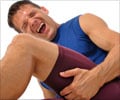The almost smothering football uniform could mean serious problems for players in summer, experts say.
The almost smothering football uniform could mean serious problems for players in summer, experts say.
Many tend to wind up in hospitals in the US, there are even reports of deaths, occasionally in high schools."The equivalent insulation to a typical football uniform is like wearing a full, three-piece men's business suit," says Larry Kenney, a professor of physiology and kinesiology at Pennsylvania State.
Sweat can't cool the player off, because it can't evaporate. Instead, it soaks his clothes, which include a helmet, shoulder pads, two shirts and sweatpants, on top of the underwear, shoes and socks.
"It's not uncommon during prolonged, intense exercise for us to be able to measure temperatures in athletes of 103 or 104 degrees Fahrenheit," Kenney told NPR radio.
Of course, there's a reason players wear all those heat-inducing layers and protective gear. Back in 1905, the relatively new sport of American football, which had few rules, was nearly banned from college campuses. Eighteen students had died on the field that year, many from head injuries and broken necks. Even U.S. President Theodore Roosevelt — a big football fan — leaned hard on college coaches to make the sport safer.
Leagues ultimately banned the "flying wedge" and other bone-crushing plays. And, eventually, helmets became standard issue, along with better padding.
Advertisement
"Practice during the cooler times of the day," he advises. "Take frequent breaks that allow players to get out of the sun and into the shade. Allow them to take their helmets off during breaks, and in some cases their shirts and shoulder pads — anything to periodically cool the players."
Advertisement
Kenney and colleagues have also come up with a chart of temperature-humidity curves that can help coaches and trainers figure out when the heat and humidity on a particular day make it too hot to practice in full pads, or when to change the practice time or move it indoors.
Source-Medindia
GPL/L









